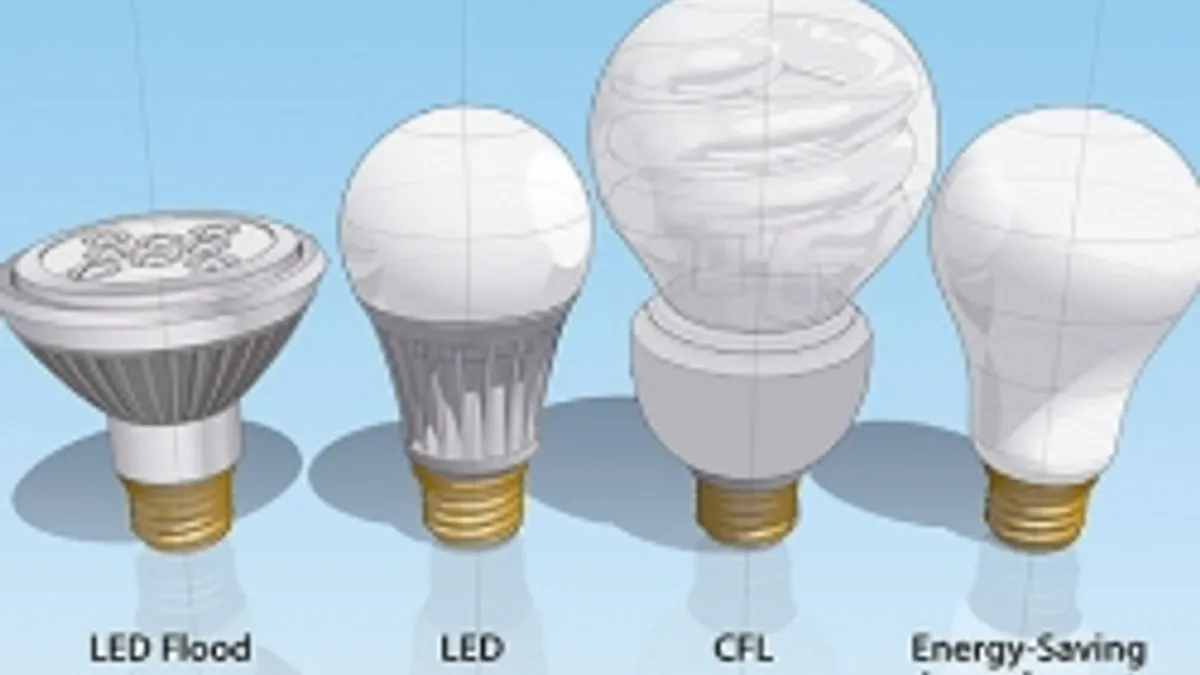Dive Brief:
- The U.S. Department of Energy wants to expand the number of light bulbs subject to federal efficiency standards, and on Tuesday issued a Notice of Proposed Rulemaking (NOPR) to bring bulbs used in about 2 billion sockets under federal regulation, including decorative fixtures, recessed and track lighting. The NOPR does not propose a new standard but alters the definition of general service lamps and general service incandescent lamps to bring more bulbs under federal rules.
- DOE also indicated it is still considering whether to initiate a "backstop," or minimum efficacy standard, of 45 lumens per watt (lm/W) for those bulbs and another 3.4 billion, effectively the entire market of common bulbs in the U.S., say experts. That could take some incandescent bulbs off of shelves, leading manufacturers to call for a transition period when older bulbs can still be sold.
- According to the Appliance Standards Awareness Project (ASAP), a phaseout out incandescent light bulbs would reduce energy use for lighting and eliminate 9.5 million metric tons of carbon dioxide emissions per year. The Obama administration in 2017 took steps to extend efficiency rules to more types of bulbs but the Trump administration reversed course after the National Electrical Manufacturers Association (NEMA) filed a lawsuit in 2017.
Dive Insight:
NEMA, which represents lighting manufacturers, declined to comment for this story but in June told DOE that it needed another year of manufacturing and importing light bulbs, followed by another year of sales, in order to ease the transition and reduce loss and waste should DOE enact the efficiency backstop.
"A phased 2-step approach will be significantly less disruptive to manufacturers and retailers and will be far easier to manage than a blanket 45 lm/W sales ban," NEMA said in its comments.
Signify, formerly known as Philips Lighting, agreed and also asked for a glide path. China filed comments with DOE as well, asking for a "transition period" of at least three years.
Signify, in a statement, said it supports a minimum efficacy requirement for general service lamps and is "focused on driving the transition to energy-efficient LED and connected LED lighting products and systems, with a natural phase-out of conventional products."
Signify said it is "in alignment" with NEMA, and believes "implementation should take effect a minimum of 12 months from the date of publication of any final rules. This will ensure a workable transition for the industry, retailers and consumers."
Efficiency advocates say delaying the standards costs consumers about $300 million each month in energy costs.
"We're talking about 19th century technology that burns out every year, which has worked out much better for the sellers than for the buyers," ASAP Executive Director Andrew deLaski said in a statement. "The LED options are so affordable and last so long that it's just predatory at this point to sell incandescent bulbs that cost a lot to use and need to be replaced frequently."
DOE hints at 'backstop' requirements
Congress set a "backstop" standard for light bulb manufacturers in 2007 that experts say is easy for LED light bulbs to meet but may take less-efficient bulbs off the market. Lawmakers set the backstop in case DOE failed to update light bulb standards to reach certain efficiency levels.
According to deLaski, currently some light bulbs are covered by standards while others are not. DOE's NOPR "would ensure that each of these bulbs would have to meet a standard," he said, including reflector bulbs, candle- bulbs and globe-shaped bulbs.
DOE's backstop standard would bring all but a few uncommon types of bulbs under an efficiency standard that manufacturers say will leave them with stranded products. There is disagreement between efficiency advocates and manufacturers, however, as to whether that standard has been triggered in the past.
Experts say DOE may be preparing to adopt the new requirement.
In a May Federal Register notice, DOE said it "is re-evaluating its understanding of the backstop requirement," and in the Tuesday NOPR, the agency reiterated that, noting "DOE has requested comments and data to inform further consideration of the 45 lm/W backstop provision."
"It is imperative that DOE provide enough time for manufacturers and retailers to plan an orderly exit from regulated product lines," NEMA said in its June comments. "Failure to provide adequate transition time would cause each manufacturer and each retailer to incur significant unexpected costs to dispose of stranded inventory."
The group added that significant losses would also mean waste material, manufacturing and transportation resources "while providing very little additional energy savings or CO2 emissions reductions."
Asked about the need for a transition period for manufacturers, ASAP pointed to its own June comments, filed jointly with several other conservation groups. The issue is one of energy equity as well as efficiency, the group said.
"Delay is costly for consumers, especially those who can least afford it, and causes needless climate change emissions," the group said. Recent modeling, according to ASAP, shows an additional year of delay before triggering the backstop would cost consumers about $3.4 billion as less efficient bulbs remain in the market.
The costs of a delay "accrue disproportionately to consumers who can least afford it. Research conducted in the metropolitan Detroit area in 2018 found that energy-efficient light bulbs are more expensive and less available in high-poverty urban areas than in more affluent locations," ASAP said.
Experts say the DOE could trigger a backstop through a Federal Register notice, but it is not clear if it would be called a proposed or final rule, or something else.
Either way, "this saga is winding to an end and the question now is whether the manufacturers are going to be able to squeeze out a few more years of profits from these wasteful products," Steven Nadel, executive director of the American Council for an Energy-Efficient Economy, said in a statement.















